Lindsay Townsend's Blog, page 27
October 4, 2010
Women do it better: The Bayeux Tapestry
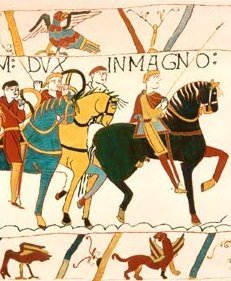 Men fought and died in England in the battle of Hastings in 1066. The kingdom and crown passed to a foreigner, William of Normandy.
Men fought and died in England in the battle of Hastings in 1066. The kingdom and crown passed to a foreigner, William of Normandy. This event is recorded in spectacular detail by the Bayeux Tapestry, made by women. There are only a few women shown on the tapestry in this story of feudal rights and obligations, claims, counter-claims and war, but scholars now agree that women made it.
The 'tapestry' is in fact an embroidery, done on strips of linen joined together to form a huge running narrative of the events leading up to and beyond the decisive battle. The seven joints are done with great skill and are almost invisible. At one time the tapestry was even longer, but the end is now damaged and incomplete. However the rest is a stunning, detailed account, a unique primary source.
Who were the women who embroidered this massive tapestry? Evidence suggests they were English. Earlier French tradition claimed the tapestry had been embroidered by William's wife Matilda, but what seems increasingly likely is that the piece was made in England as a gift for the new queen.
English female embroiderers were famous throughout Europe for their wall-hangings and church garments. Earlier English queens, such as Edith, were acclaimed for their skill as embroiders. A wall hanging made by English embroiders, showing the defeat of the English at the battle of Maldon in 991, was given to the monastery at Ely by the defeated leader's widow, Aelflaed, as a memorial to the English dead. The Bayeux Tapestry may have partly served as a memorial to the English dead and have even been stitched by some English widows at either Winchester, the seat of the court and government in Anglo-Saxon England, or Canterbury, or the nunnery at the Minster in Sheppey in Kent - all famed centres of English embroidery. In some cases we may even know their names, such as the woman Leofgeat, who in 1086 in the Domesday Book is described as doing gold embroidery for the king.
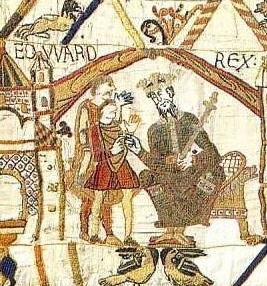 Gold was not used in the Bayeux Tapestry, but wool thread dyed sage green, blue-green, red, buff and blue were stitched on the linen using an outline and stem stitch, then laid and couched stitches, making the whole stand out in low relief, like a sculptor's frieze. The figures are active and the tumult of the battle is shown. The English warriors with their moustaches and longer hair are picked out, and the Normans with their cropped locks, and several of the key moments of 1066 are there – Halley's comet, as a presager of trouble, William, lifting up his helmet to reveal his face and prove he's still alive, and the climax of the battle, where Harold is felled by the arrow.
Gold was not used in the Bayeux Tapestry, but wool thread dyed sage green, blue-green, red, buff and blue were stitched on the linen using an outline and stem stitch, then laid and couched stitches, making the whole stand out in low relief, like a sculptor's frieze. The figures are active and the tumult of the battle is shown. The English warriors with their moustaches and longer hair are picked out, and the Normans with their cropped locks, and several of the key moments of 1066 are there – Halley's comet, as a presager of trouble, William, lifting up his helmet to reveal his face and prove he's still alive, and the climax of the battle, where Harold is felled by the arrow.A woman is also behind a faithful facsimile of the tapestry. In 1885 Elizabeth Wardle saw the original at Bayeux and, along with 35 other women, was inspired to produce a copy, to be housed in England. This is now kept at the museum in Reading, England.
The fame of English embroidery led me to make Sunniva, the Anglo-Saxon heroine of A Knight's Captive, amongst her other talents a skilled seamstress.
Published on October 04, 2010 03:26
September 5, 2010
Medieval cooking and 21st-century schools
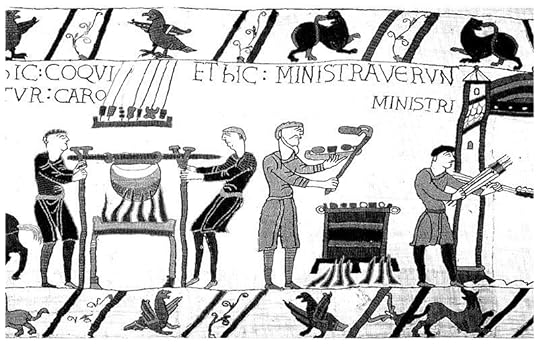 The BBC website has an interesting piece today about a project bringing a taste of medieval diet to some schools in Yorkshire, history and health lessons all in one. Funded by the Wellcome Trust, the plan is to highlight the differences between medieval food - high in grains and vegetables for the poor, more meat and spices for the rich, and no snacking! - with the food we eat now.
The BBC website has an interesting piece today about a project bringing a taste of medieval diet to some schools in Yorkshire, history and health lessons all in one. Funded by the Wellcome Trust, the plan is to highlight the differences between medieval food - high in grains and vegetables for the poor, more meat and spices for the rich, and no snacking! - with the food we eat now.
Published on September 05, 2010 08:10
August 25, 2010
I've been away... in Derbyshire
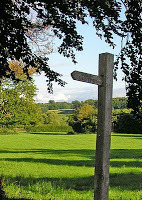 We managed to go away this weekend for a flying visit over the border into deepest Derbyshire. It's a beautiful county if you love little woods, rivers, fields and 'curvy' landscapes - which we do. It's fertile and rich in history, too - ancient history with its sacred springs and more recent with its scattering of medieval, Tudor and Georgian houses, of which Chatsworth and Haddon Hall are two of the more famous.
We managed to go away this weekend for a flying visit over the border into deepest Derbyshire. It's a beautiful county if you love little woods, rivers, fields and 'curvy' landscapes - which we do. It's fertile and rich in history, too - ancient history with its sacred springs and more recent with its scattering of medieval, Tudor and Georgian houses, of which Chatsworth and Haddon Hall are two of the more famous.We stayed (technically just over the county boundary in Staffordshire) at Mayfie...
Published on August 25, 2010 05:08
August 5, 2010
UK Kindle editions
 Good news for UK readers! Amazon Kindle editions are now available from their UK site, so I've updated my book pages with the new links. All the Kensingtons and almost all the Bookstrands are available, including one or two not previously sold in the UK in any form. You can find them all listed here
Good news for UK readers! Amazon Kindle editions are now available from their UK site, so I've updated my book pages with the new links. All the Kensingtons and almost all the Bookstrands are available, including one or two not previously sold in the UK in any form. You can find them all listed here .
.
Published on August 05, 2010 01:49
July 26, 2010
'A Knight's Enchantment': review roundup
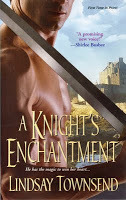 I've been delighted at some of the reviews my latest medieval has been gathering:
I've been delighted at some of the reviews my latest medieval has been gathering: Night Owl Reviews have just made it a Top Pick . Terri says she'd like to see more about the characters because she's still thinking about them and goes on, 'I believe Ms Townsend has raised the bar for this era for many of her fellow authors.'
Lauren Calder at Affaire de Coeur writes: 'Ms. Townsend sneaks into the heart of the reader and continually snags them with her enchanting story, feisty characters, and bl...
Published on July 26, 2010 01:34
July 4, 2010
The difference of historicals
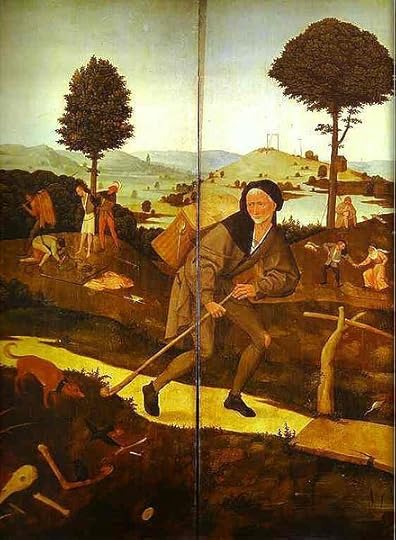 I've drawn the winners of my latest contest, and copies of A Knight's Enchantment are on their way to the lucky three. Now I'd like to point out a few ways in which historicals are - well, different. I love reading historical novels of all genres and I love to write them, so are my five 'star' points that I look out for in the stories that I really enjoy.
I've drawn the winners of my latest contest, and copies of A Knight's Enchantment are on their way to the lucky three. Now I'd like to point out a few ways in which historicals are - well, different. I love reading historical novels of all genres and I love to write them, so are my five 'star' points that I look out for in the stories that I really enjoy.1. Realistic reactions. In the past, the roles and pressures on people were different to now and a good historical reveals this. Women's li...
Published on July 04, 2010 05:52
June 21, 2010
'A Knight's Enchantment' contest - two questions, three prizes
 I have three signed copies of A Knight's Enchantment to give away to the three lucky winners of my instant quiz. All you have to do to get your name in the battered straw hat is to answer one of these questions based on my previous 'Knight' books:
I have three signed copies of A Knight's Enchantment to give away to the three lucky winners of my instant quiz. All you have to do to get your name in the battered straw hat is to answer one of these questions based on my previous 'Knight' books:1. In A Knight's Vow, what is the name of the castle where Alyson lives?
2. In A Knight's Captive, who is the saint whose shrine Sunniva and Marc are on pilgrimage to visit?
Simple! Just email me a correct answer by midnight on June 30, 2010 and enchan...
Published on June 21, 2010 05:35
'A Knight's Enchantment' - two questions, three prizes
 I have three signed copies of A Knight's Enchantment to give away to the three lucky winners of my instant quiz. All you have to do to get your name in the battered straw hat is to answer one of these questions based on my previous 'Knight' books:
I have three signed copies of A Knight's Enchantment to give away to the three lucky winners of my instant quiz. All you have to do to get your name in the battered straw hat is to answer one of these questions based on my previous 'Knight' books:1. In A Knight's Vow, what is the name of the castle where Alyson lives?
2. In A Knight's Captive, who is the saint whose shrine Sunniva and Marc are on pilgrimage to visit?
Simple! Just email me a correct answer at lindsaytownsend@yahoo.co.uk by midni...
Published on June 21, 2010 05:35
June 1, 2010
'A Knight's Enchantment' published today!
 My historical romance, A Knight's Enchantment, is released today by Kensington Zebra. This is my third knight novel, the other two being A Knight's Vow and A Knight's Captive. They take place in different time periods and different places, but all have knights as their heroes.
My historical romance, A Knight's Enchantment, is released today by Kensington Zebra. This is my third knight novel, the other two being A Knight's Vow and A Knight's Captive. They take place in different time periods and different places, but all have knights as their heroes.For me the appeal of a knight isn't his shining armour or his wealth. It isn't even the knightly code which he would be supposed to follow: too often in the middle ages, such ideas of courtesy and honour applied only...
Published on June 01, 2010 00:00
May 13, 2010
Setting the scene for 'A Knight's Enchantment'
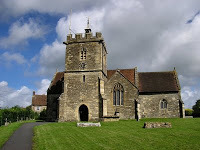 One of the pleasures of writing historical fiction is the chance to explore the way places were hundreds of years ago, so, as part of my background research for A Knight's Enchantment, I paid a visit to the West Country.
One of the pleasures of writing historical fiction is the chance to explore the way places were hundreds of years ago, so, as part of my background research for A Knight's Enchantment, I paid a visit to the West Country.Templecombe, where some of my scenes are set, is one of those thousands of English villages with a quiet present and a busy past, sitting in a land of wide green valleys and warm golden stone on the Somerset/Dorset border with the abbey towns of Shaftesbury to the east, Sherb...
Published on May 13, 2010 05:00



